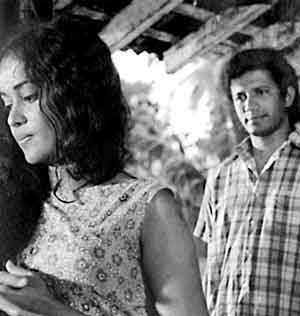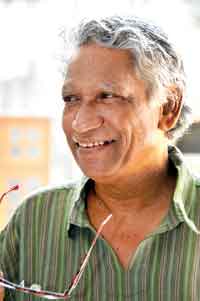Pathiraja’s fearless exposure of social issues on the silver screen

A still from ‘Eya Dan Loku Lamayek’
For University colleagues of film-maker Dr.Dharmasiri Pathiraja or Pathi as he is more popularly known, he is the intellectual of contemporary cinema who paved the way for a socially engaged cinema in Sri Lanka. Members of the Alumni of the University of Ceylon 1960-1969 celebrating his cinematic journey of 50 years spoke about his inspirations, empathy and of his fearless exposure of social issues through the cinematic medium. As Pathi is convalescing, he could not be present at the event. His comrades nevertheless carried on and Alumni President Nimal Nanayakkara pointed out that Pathi’s early cinematic efforts were not only humanistic but also had forebodings for the future.
What drew him to make films on social issues?
At the time Pathi left the University in 1968, most of those who had passed out found themselves unemployed. The economic prospects were gloomy and the instability in urban areas was causing restlessness among the youth. The country was heading towards political turmoil.
With his sights set in the cinema, Pathi set out to exploit the cinematic medium to bring out the poignancy of the situation to the screen. This earned him the reputation of making cinema of social relevance which made him a colossus in Sinhala cinema.
His career, which brought him the most coveted awards locally and international accolades to the country, was felicitated by the state titled “Pathi’s 50” under the patronage of President Maitripala Sirisena a few months ago.
His colleagues however who paid their tributes without any fanfare, emphasised the fact that Pathi commenced his cinematic career as an academician which did contribute towards the calibre of his films. He passed out from the then University of Ceylon, Peradeniya with a Honours Degree in Sinhala and Western Classical Culture, obtained his Master’s Degree (MA) and followed Post Graduate studies in Drama at Peradeniya. He served as lecturer in Drama and Performing Arts at Kelaniya, Ruhuna, Colombo and Jaffna Universities and also served as Chairman of the Sri Lanka Media Training Institute.
An active member of the Film Society Movement of the 1960s, Pathi closely studied the cinematic traditions of Mrinal Sen, Satyajit Ray and Ritwik Ghatak which may have influenced his trend of film direction. His dissertation for his Ph.D from the Monash University, Australia was on “The Dialectic of the Region and the Nation in films of Bengali Independence: Ghatak, Ray and Sen.”
His comrades were particularly pleased that Pathi did not take refuge in novels which dealt with love and romance, detectives or imaginary heroics as the basis for his films. Berty Gunasekere commended him for his matured approach as Pathi instead drew inspiration from his known surroundings and made deep insights into contemporary society bringing out the social imbalances and hardships especially of the youth of the lower urban class. And skillfuly presented them as cinematic creations.
Pathi made his first short film “Sathuro” in 1970. His first major feature film “Ahas Gavva” however was made four years later when he peeped into the nooks and corners of the city and portrayed the economic hardships of the youth seeking jobs. The fact that the film carried away the plum Awards for his first efforts at film-making – Best Picture, Best Director and Best Actor of the FCJAC (Film Critics and Journalists Association) and Best Film and Best Director of the OCIC Awards (Office Catholique International Du Cinema: Sri Lanka) speaks of the standards he reached in projecting the burning issues from the beginnings of his career.

Dharmasiri Pathiraja: A trail balzer in the local cinema scene
Pathi went on to make his next film “Eya Dan Loku Lamayek” in the following year which brought him for the first time international recognition. The film was Sri Lanka’s entry at the Ninth Moscow International Film Festival which won a Special Diploma for Female Performance in 1976. It also won a Special Award from the Peace Council of the USSR which enabled its screening at the Eighteenth Venice Film Festival in Bergano, Italy as Sri Lanka’s entry.
His next was “Bambaru Avith” made in 1978 based on the life of fishermen which proved a winner once again and which carried away the Awards – Best Director and Best Film at the First Presidential Film Awards. It also won the OCIC Awards while the Special Council set up to celebrate Fifty years of Sri Lankan Cinema named it as the “Fourth Best Sri Lankan Film of All Time.” Pathi’s versatility was proven when he made the very sensitively crafted Tamil film “Ponmani” in the same year. The film was screened at the prestigious International Film Festival in India.
“Soldadu Unnahe” made in 1981 elevated him further as a winner. It was screened at the Eighth International Film Festival in India and won the Best Director, Best Film and the Best Script Awards at the Third Presidential Film Awards. OCIC awarded it the Best Director and Best Film Awards while naming it as the Best Film of Sri Lanka in the 1980-1990 period.
Pathi was also seen in full flight with social issues in “Paara Dige” and “Mathu Yam Davasaka” where he depicted the traditional society’s struggle to interact with the challenges of modern life. “Mathu Yam Davasaka” was screened at the Singapore International Film Festival as well as at the Fourth Asian and Arab Cinema in New Delhi. Earlier in the year 2000, Pathi had been decorated with the iconic “Golden Lion” at the Sixteenth International Film Festival in Singapore when he was awarded the “Once a Lifetime” Award.
The role he played in stage plays such as “Kora saha Andhaya” and “Putu” and the opening of new paths on the small screen, were not left out in the tributes paid to him by his colleagues. Berty Gunasekere said that through “Kadulla” which in 1992 won him the Award for the Best Teledrama, as well as in “Ella LangaWalawwa,” “Maya Mandeera” and “KanpithaVil,” he demonstrated that teledramas could be more than a simple artistic medium. That it could be brought to the sitting room as a compelling social experience.


